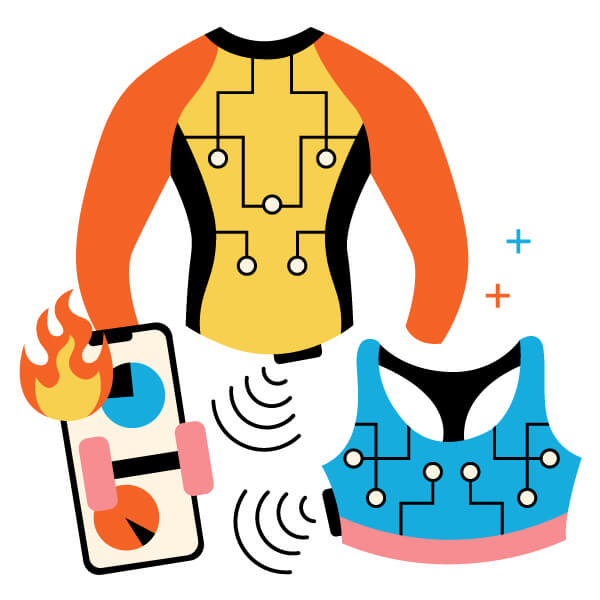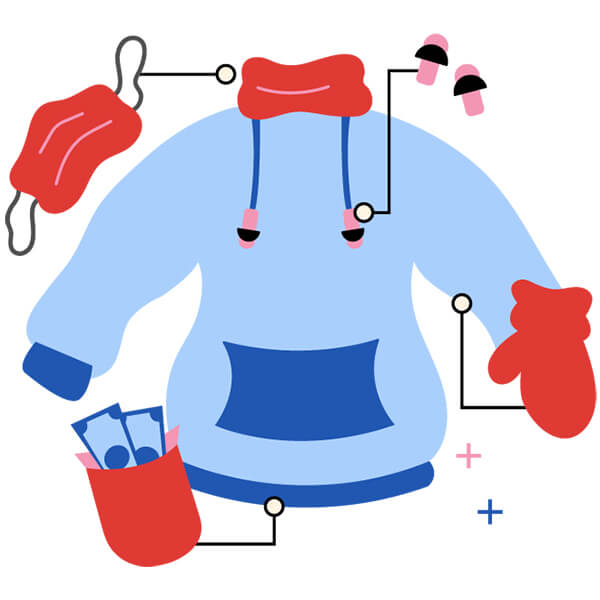Smartly Dressed
When you think of wearable technology, the first thing that probably comes to mind is a smartwatch or a Fitbit. But in the not-too-distant future, wearables will become more integrated into our outfits. Instead of donning a distinct device, you may simply throw on a piece of clothing with electronic sensing capabilities that can monitor your health, fitness and more. These USC Viterbi professors and students are designing cutting-edge textiles and sensors — as well as low-tech, high-impact clothing prototypes — that meld fashion and function.

Smart Maternity Bra
Nursing mothers concerned that their morning coffee or evening wine might affect their babies’ health will benefit from this bra being developed by Maral Mousavi, WiSE Gabilan Assistant Professor and assistant professor of biomedical engineering, that detects the levels of alcohol and caffeine in the wearer’s breast milk. Conductive metallic yarn is treated with enzymes that react to molecules of interest in the milk and embroidered onto the bra’s fabric. The signals produced by these reactions are measured by a flexible circuit that is embedded in the bra, and the data is sent to an app on the wearer’s smartphone.
The visualized data can help guide decisions about the timing of feedings by indicating when alcohol or caffeine is present in breast milk in levels that may be dangerous to a nursing infant. Mousavi, who was motivated to work on the bra to address the dearth of wearables designed explicitly for women’s and mothers’ health concerns, estimates that the bra will be available commercially within three years.

Respiratory Health Shirt
This shirt developed by Yasser Khan, assistant professor of electrical and computer engineering, can monitor respiratory health — and it’s arguably more comfortable and stylish than, say, wearing a chest-strap monitor. Sensors woven into the fabric with conductive metallic yarn measure respiration rate and can detect labored breathing. A machine learning algorithm tracks how frequently and intensely the wearer coughs, with over 95% accuracy. Respiratory data can be viewed in the linked app.
The shirt’s ease of use and low fabrication cost make it suitable for widespread use in hospitals to help monitor the severity of COVID-19 and other respiratory diseases. Khan anticipates the shirt will be available in health care settings within a few years.

Athletic Base Layer and Sports Bra
This activewear is crafted with a smart textile pioneered by Gianluca Lazzi, Provost Professor of Ophthalmology, Electrical and Computer Engineering, Clinical Entrepreneurship, and Biomedical Engineering. Lazzi co-invented fibers based on a liquid metal called eutectic gallium-indium; these fibers are electronic sensors that can stretch like rubber bands and are integrated into garments. As they expand and contract, the sensors send data to a small modular processing unit that attaches to the garments.
Wearers of the athletic base layer or sports bra can monitor their respiration and ventilation rates and track their level of effort during or after physical activity with the linked app. These metrics may be useful to people aiming to optimize their athletic training or monitor calories burned. Lazzi also envisions a variety of health applications, such as tracking the respiration patterns of those with sleep apnea. The machine-washable base layer and sports bra will be available for purchase through Teveri Inc., a company that Lazzi co-founded, in 2024.

Humanitarian Sweater
This multitasking sweater was designed by a group of students in the Innovation in Engineering Design for Global Challenges course, co-taught by Daniel Druhora, a lecturer of civil and environmental engineering, to meet the needs of Syrian and Afghan refugees in the Moria refugee camp in Lesbos, Greece. Josh Neutel, B.S. CHEM ’19, headed up the design team that traveled to Greece in 2018 and 2019 to assess the refugees’ clothing needs and test prototypes.
Nearly every feature of the sweater does double duty: The sleeves can be unfolded and worn as mittens. Hidden pockets keep passports and cash safe. Drawstrings at the neck feature earplugs. The turtleneck can be converted into a face mask. Neutel, now a doctoral student at Stanford University, is seeking partners to bring the design to market to benefit refugees around the world.



